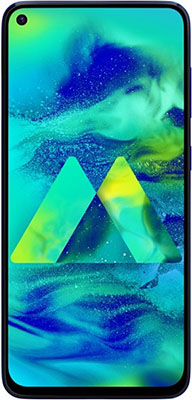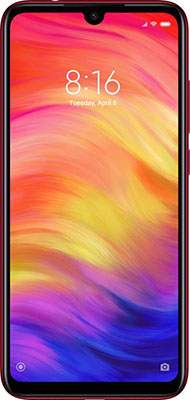Samsung Galaxy M40 VS Redmi Note 7 Pro: Samsung’s resurgence vs the budget king, which one to buy?
This is the comparison between two one of the best and hottest smartphones right now
Rank :
#2
|
Our Score
88
Out of 100
|
|
|
|
|
|
|
|
|
|
|
|
|
|
|
|
|
|
|
Rank :
#1
|
Our Score
89
Out of 100
|
|
|
|
|
|
|
|
|
|
|
|
|
|
|
|
|
|
|
| Performance |
Almost similar Performance
|
Almost similar Performance
|
| Rear Camera |
It has around 1% better Rear Camera quality
|
|
| Front Camera |
It has around 3% better Front Camera quality
|
|
| Design |
It has around 5% better Design
|
|
| Display |
Almost similar Display quality
|
Almost similar Display quality
|
| Battery |
It has around 14% better Battery backup
|
|
| Features |
It has around 8% more Features
|
|
| Connectivity |
Almost similar Connectivity options
|
Almost similar Connectivity options
|
| Value for Money |
It has around 9% more Value for Money
|
|
| User Experience |
Almost similar User Experience
|
Almost similar User Experience
|
| RAM |
Same RAM Size
|
Same RAM Size
|
| Screen Size |
Same Screen Size
|
Same Screen Size
|
| Storage |
Same Internal Storage
|
Same Internal Storage
|
| Thickness |
It has 0.2 mm (2%) Slimmer body
|
|
| Weight |
It is 18 grams (10%) lighter
|
|
| Age |
It is 110 days younger
|
Suitable for? |
Samsung Galaxy M40 |
Xiaomi Redmi Note 7 Pro (6 GB) |
| Heavy Users | ||
| Normal Day to Day Users | ||
| Heavy Gamers | ||
| Moderate Gamers | ||
| Camera Lovers | ||
| Selfie Lovers | ||
| Multimedia Consumption |
Conclusion: Samsung Galaxy M40 vs Xiaomi Redmi Note 7 Pro (6 GB)
After resurging in the budget smartphone segment, Samsung has now launched the Galaxy M40 which comes with the same powerful SD 675 processor and is the direct challenger to the budget smartphone king, the Redmi Note 7 Pro. While both the Galaxy M40 and Redmi Note 7 Pro have their pros and cons, which you can read in our separate posts, there are 3 major factors – display, UI & price which differentiates the two; rest other things are more or less similar.
The first and most important thing is the display. The Galaxy M40 comes with a hole punch display which clearly looks more beautiful, consumes less space and is less obstructive compared to the dot notch present in the Redmi Note 7 Pro. Design-wise, the Galaxy M40 looks a little better but the Redmi Note 7 Pro clearly has a better and premium build with the glass back. The second major difference is the user interface of the two phones, the Galaxy M40 comes with Samsung’s new One UI while the Redmi Note 7 Pro comes with Xiaomi’s MIUI which is already facing criticism for ads in the UI, but even if you ignore the ads, the One UI is more beautiful, modern, feature-rich and easy to use and gets more points. Although the Galaxy M40 has an upper edge in terms of display and UI, the Redmi Note 7 Pro is ₹3,000 cheaper which is a great deal.
Finally, to sum it up, whether to go for the Galaxy M40 or the Redmi Note 7 Pro depends primarily on which ecosystem you want to go into, Samsung’s or Xiaomi’s. While Samsung’s charges you more premium, it also delivers a more premium user experience especially with its hole punch style Infinity O Display and the One UI, which are reasons enough if you are willing to spend some extra amount, otherwise the Redmi Note 7 Pro has a leading edge in terms of cameras, build, battery, price and is close to perfect for its price.
Full Specifications |
Samsung Galaxy M40 |
Xiaomi Redmi Note 7 Pro (6 GB) |
| Phone Name(s) | Samsung Galaxy M40 | Xiaomi Redmi Note 7 Pro |
| Manufacturer | Samsung | Xiaomi |
| Announced | June 2019 | February 2019 |
| Released | June 2019 | February 2019 |
| Build | Plastic body | Front and Back 2.5D Glass |
| Colors |
Midnight Blue
Seawater Blue
|
Space Black
Neptune Blue
Nebula Red
|
| Dimensions | 155.3 x 73.9 x 7.9 mm | 159.21 x 75.21 x 8.1 mm |
| Weight | 168 grams | 186 grams |
| Buttons | On-screen navigation buttons, Power button, Volume rocker | On-screen navigation buttons, Power button, Volume rockers |
| Screen Size | 6.3 inches | 6.3 inches |
| Display Type | Bezel-less IPS LCD Infinity O Display with front camera hole | IPS LCD bezel-less display with Dot notch |
| Resolution | FHD+ (2340 x 1080 pixels) | FHD+ (2340 x 1080 pixels) |
| Pixel Density | 409 pixels per inch (PPI) | 409 pixels per inch (PPI) |
| Aspect Ratio | 19.5:9 aspect ratio | 19.5:9 aspect ratio |
| Display Area | 91.8% screen-to-body ratio | 81.4% screen-to-body ratio |
| Protection | Corning Gorilla Glass 3 | Corning Gorilla Glass 5 (Front & Back) |
| Touchscreen | Yes, Capacitive, Multitouch | Yes, Capacitive, Multitouch |
| Processor | Octa-Core Qualcomm Snapdragon 675 (2x2.0 GHz Kryo 460 Gold cores & 6x1.7 GHz Kryo 460 Silver cores), 11nm | Octa-Core Qualcomm Snapdragon 675 (2x2.0 GHz Kryo 460 Gold cores & 6x1.7 GHz Kryo 460 Silver cores), 11nm |
| RAM | 6 GB | 6 GB |
| GPU | Adreno 612 GPU | Adreno 612 GPU, upto 845MHz |
| Internal | 128 GB | 128 GB (eMMC 5.1 flash storage) |
| External | microSD up to 512 GB | microSD up to 256 GB |
| USB OTG | Yes | Yes |
| OS | Android 9.0 Pie | Android 9.0 Pie |
| User Interface | One UI | MIUI 10 |
| Rear Camera | 32 MP + 8 MP + 5 MP triple cameras with Single LED flash | 48 MP + 5 MP Dual cameras with Dual LED flash |
| Details | 32 MP sensor: f/1.7 aperture lens, PDAF 8 MP sensor (ultrawide): f/2.2 aperture lens, 123 degree wide angle, 1.12µm 5 MP sensor (depth sensor): f/2.2 aperture lens, Live focus |
Primary sensor: Sony sensor, f/1.79 aperture lens; Secondary sensor: f/2.4 aperture lens; 1.6μm large pixel (4-in-1 Super Pixel), PDAF, Steady handheld night photography, AI Portrait mode, Background blurring, Single-tone flash, Low light enhancement, Standard HDR, Auto HDR, Video stabilization (EIS), Burst mode, Panorama mode, Face recognition, AI Dynamic bokeh, AI Studio lighting, AI Scene detection (33 scene categories) |
| Video Recording | 4K (2160p) @30fps, FHD (1080p) @30fps, Slow-mo @240fps, Hyperlapse | 4K @30fps, 1080p @60/30fps, 720p @30fps, 720p slow motion @120fps, 1080p slow motion @120fps |
| Front Camera | 16 MP | 13 MP |
| Details | f/2.0 aperture lens | AI Portrait mode, Background blurring, AI Beautify, Face recognition, Selfie timer, HDR, AI Studio lighting, AI Scene detection (12 scene categories) |
| Video Recording | FHD (1080p) @30fps | 1080p/ 720p @30fps |
| SIM | Dual SIM (hybrid slots) | Hybrid Dual SIM (Dual 4G, Dual VoLTE) |
| SIM Size | Nano SIM | Nano SIM |
| Capacity | 3500 mAh Li-Po battery | 4000 mAh Li-Po battery |
| Fast Charging | Yes, 15W fast charging | Yes, 5V/2A charger included, supports Quick Charge 4.0 |
| Wireless Charging | No | No |
| Removable Battery | No | No |
| Security | Fingerprint Scanner, Face Unlock | Fingerprint Scanner, Face Unlock |
| Sensors | Accelerometer, Gyro Sensor, Geomagnetic Sensor, Proximity Sensor, Virtual Light Sensing | Gyroscope, Accelerometer, Proximity sensor, Electronic compass, Ambient light sensor, Vibration motor, IR blaster |
| Wi-Fi | 802.11 a/b/g/n/ac, 2.4 GHz + 5 GHz Dual Band, Wi-Fi Direct, Wi-Fi Hotspot | 802.11a/b/g/n/ac, 2.4 GHz + 5 GHz Dual Band, Wi-Fi Direct, Wi-Fi Hotspot |
| Bluetooth | v5.0 | 5.0, A2DP, LE |
| Location | GPS, Glonass, Beidou | GPS, A-GPS, GLONASS, BeiDou |
| USB Type | USB Type-C | USB Type-C 2.0 |
| FM Radio | Yes | Yes |
| NFC | Yes | No |
| Infrared | No | Yes |
| Speakers | Yes (bottom mounted), Dolby Atmos, Screen Sound Technology | Yes (bottom mounted) |
| 3.5mm Headphone Jack | No | Yes |
| Microphone | One primary microphone and one dedicated microphone for Active noise cancellation | One primary microphone and one dedicated microphone for Active noise cancellation |
| Cellular Networks | 2G, 3G, 4G / VoLTE | 2G, 3G, 4G / VoLTE |
| 2G Bands | GSM: 850/900/1800/1900 | GSM : B2, B3, B5, B8 |
| 3G Bands | HSDPA: 850/900/1900/2100 | WCDMA : B1, B2, B5, B8 |
| 4G Bands | - | FDD-LTE : B1, B3, B5, B8 TDD-LTE : B40, B41(120MHz) |
| Speed | - | - |
| Head | 0.20 W/kg | 0.962 W/kg |
| Body | - | 0.838 W/kg (distance 15mm) |
| Notification LED | No | Yes (bottom mounted) |
| Water Resistance | No | Water repellent P2i nano coating |
| What's in the box? | Samsung Galaxy M40, Travel Adapter, USB Cable, Ejection Pin and User Manual | Redmi Note 7 Pro, Power adapter, USB cable, SIM eject tool, User guide, Clear soft case |


 2.0 GHz Octa-Core Snapdragon 675
2.0 GHz Octa-Core Snapdragon 675
 6 GB RAM
6 GB RAM
 Android 9.0 Pie
Android 9.0 Pie  6.3 inches (FHD)
6.3 inches (FHD)  Dual Sim
Dual Sim
 32,8,5MP + 16MP
32,8,5MP + 16MP
 3,500 mAh
3,500 mAh
 128 GB Internal
128 GB Internal
 512 GB microSD
512 GB microSD
 Fingerprint, Face Unlock, 15W Charging
Fingerprint, Face Unlock, 15W Charging 






